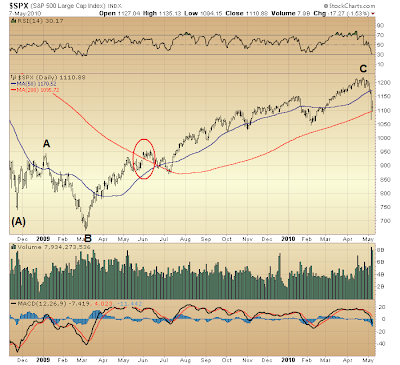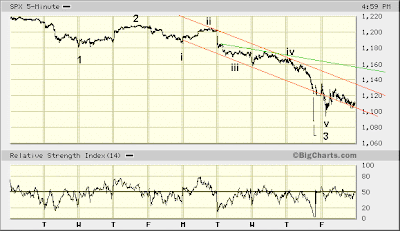Having come across a Reuters article ("New regulations likely as U.S. probes big stock dive") comprehensively summarizing news surrounding Thursday's stock market dislocation, I noted a subtle attempt being made to direct inquiry into the "who" behind Thursday's meltdown away from Wall Street and toward those seeking financial regulatory reform. Given the source this really comes as no surprise. Wisdom advises the opposite view, however.
Namely, might chaos have been the orchestrated response to certain efforts at strengthening (via amendments) the Restoring American Financial Stability Act of 2010 currently being debated in the U.S. Senate? This prospect would add very serious substance to yesterday's, "It was a fat finger alright!"
And just to be clear... Fingers don't get that fat: error, manipulation or cyberattack? ... is a more thoughtful and experienced point of view. As for this article's concluding hope, though, what if Thursday's operation was neither about "plain old greed," nor "a test run?"
What if the "fat finger" in fact was reacting to Senators Cantwell and McCain introducing on Thursday an amendment to the so-called "Dodd bill" aiming to restore safeguards modeled on the 1933 Glass-Steagall Act? (Press Release of Senator Cantwell)
In other words, was the evaporation of Thursday's bid purposely sending a message announcing an intention that, were investment banks forbidden from owning federally insured depository institutions essential to commerce, then even those investments generally perceived as being among the world's safest will be driven into the ground?
Again, consider which companies were in the vortex of Thursday's maelstrom — Proctor & Gamble and 3M. Although nothing is set in stone, these two companies probably will remain relatively intact following any further collapse of the global financial system. Likewise, one is hard-pressed to imagine how operations at either of these companies might face life-and-death challenges were the euro to disintegrate — a probability whose likelihood gained a lot of traction this week.
Might one conclude the same about, say, JP Morgan Chase, however? Given financial fragility exposed this week in the euro-zone, how was it that share prices of a couple major industrial companies came under attack, rather than a number of hopelessly bankrupt financial firms trillions deep in derivatives securities that are short on markets and long on fancy?
Consider, too, the time of day Thursday's dislocation occurred...
According to Mark Fisher of MBF Clearing Corp. a prospective $20 collapse in the price of crude oil probably was avoided by the fact oil markets were closed when the stock market imploded. Of course, the possibility of such a coincident steep loss in crude is but a matter of conjecture. However, indisputable is the fact that, all things oil are dominated by the very same interests whose super-leveraged booty requires every last dime of capital available to maintain some appearance of solvency. Wages gouged at the pump over the past five years, as well as greater access to commercial bank deposits have become critical capital fonts.
So, the hour at which the rug was pulled out from under the stock market might prove a fruitful line of inquiry when the House Financial Services Subcommittee on Capital Markets, Insurance, and Government Sponsored Enterprises holds a hearing on Tuesday to address the causes of Thursday's swoon. The "who" and the "why" behind it might be more quickly discovered, too, particularly given which companies were targeted. We just might learn the "fat finger" pictured yesterday belonged to some materially at risk, "fat cat banker," who, seeing the prospect of Glass-Steagall restored, perceives a threat rather than a face saving way forward...

In light of an outlook supposing a decline back to March '09 lows (and beyond) has begun ... it appears possible that, action around the 200-day moving average at this early stage might be similar (but in reverse) to what developed only one year ago ... when major indexes penetrated respective 200-day moving averages to the upside during formation of the first wave of a five-wave, counter-trend rally.
It was during formation of the fifth wave of the first wave up from March '09 bottom that the S&P 500 penetrated its 200-day moving average. And now, with the first wave down from top unfolding it appears its fifth wave, too, might prove a decisive move confirming reversal of the counter-trend rally since March '09.

Given the general state of technical measures typically presented here — specifically, well-done to the downside — there is good reason to suppose the immediate worst of this initial move lower is passed.
Straight ahead, then, appears a corrective period consolidating last week's losses. Once this is completed, though, be on the lookout for the S&P 500's decisive downside penetration of its 200-day moving average finishing its initial descent from last month's top.
A large move lower driven by intrigues surrounding financial regulatory reform quite evidently appears in store, seeing as "fat fingers" these past few weeks (and particularly yesterday) look to develop whenever anything resembling stricter Wall Street oversight enters into the picture. Considering the coming election season is likely to be hotter than Hiroshima on August 6, 1945, "fat fingers" might have all the explosive fuel they need to become an equally unimaginable and devastating trend.
Consider this outlook, too, in light of insights offered today by John Tabacco...
Seems me and some deep pockets are seeing things quite similarly.

* * * * *
© The Risk Averse Alert — Advocating a patient, disciplined approach to stock market investing. Overriding objective is limiting financial risk. Minimizing investment capital loss is a priority.
Analysis centers on the stock market's path of least resistance. Long-term, this drives a simple strategy for safely investing a 401(k) for maximum profit. Intermediate-term, investing with stock index tracking-ETFs (both their long and short varieties) is advanced. Short-term, stock index options occasionally offer extraordinary profit opportunities when the stock market is moving along its projected path.
Nothing is set in stone. Nor is the stock market's path of least resistance always known. More often than not, there are no stock index option positions recommended.
 There's an easy way to boost your investment discipline...
There's an easy way to boost your investment discipline...Get Real-Time Trade Notification!



















